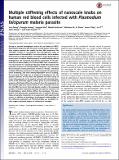Multiple stiffening effects of nanoscale knobs on human red blood cells infected with Plasmodium falciparum malaria parasite
Author(s)
Zhang, Yao; Huang, Changjin; Kim, Sangtae; Golkaram, Mahdi; Dixon, Matthew W. A.; Tilley, Leann; Li, Ju; Zhang, Sulin; Suresh, Subra; ... Show more Show less
DownloadZhang-2015-Multiple stiffening.pdf (1.270Mb)
PUBLISHER_POLICY
Publisher Policy
Article is made available in accordance with the publisher's policy and may be subject to US copyright law. Please refer to the publisher's site for terms of use.
Terms of use
Metadata
Show full item recordAbstract
During its asexual development within the red blood cell (RBC), Plasmodium falciparum (Pf), the most virulent human malaria parasite, exports proteins that modify the host RBC membrane. The attendant increase in cell stiffness and cytoadherence leads to sequestration of infected RBCs in microvasculature, which enables the parasite to evade the spleen, and leads to organ dysfunction in severe cases of malaria. Despite progress in understanding malaria pathogenesis, the molecular mechanisms responsible for the dramatic loss of deformability of Pf-infected RBCs have remained elusive. By recourse to a coarse-grained (CG) model that captures the molecular structures of Pf-infected RBC membrane, here we show that nanoscale surface protrusions, known as “knobs,” introduce multiple stiffening mechanisms through composite strengthening, strain hardening, and knob density-dependent vertical coupling. On one hand, the knobs act as structural strengtheners for the spectrin network; on the other, the presence of knobs results in strain inhomogeneity in the spectrin network with elevated shear strain in the knob-free regions, which, given its strain-hardening property, effectively stiffens the network. From the trophozoite to the schizont stage that ensues within 24–48 h of parasite invasion into the RBC, the rise in the knob density results in the increased number of vertical constraints between the spectrin network and the lipid bilayer, which further stiffens the membrane. The shear moduli of Pf-infected RBCs predicted by the CG model at different stages of parasite maturation are in agreement with experimental results. In addition to providing a fundamental understanding of the stiffening mechanisms of Pf-infected RBCs, our simulation results suggest potential targets for antimalarial therapies.
Date issued
2015-05Department
Massachusetts Institute of Technology. Department of Materials Science and Engineering; Massachusetts Institute of Technology. Department of Nuclear Science and EngineeringJournal
Proceedings of the National Academy of Sciences
Publisher
National Academy of Sciences (U.S.)
Citation
Zhang, Yao, Changjin Huang, Sangtae Kim, Mahdi Golkaram, Matthew W. A. Dixon, Leann Tilley, Ju Li, Sulin Zhang, and Subra Suresh. “ Multiple Stiffening Effects of Nanoscale Knobs on Human Red Blood Cells Infected with Plasmodium Falciparum Malaria Parasite .” Proc Natl Acad Sci USA 112, no. 19 (April 27, 2015): 6068–6073.
Version: Final published version
ISSN
0027-8424
1091-6490